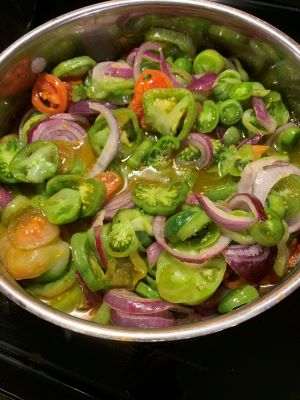This is a revised version of an article Mary Elizabeth originally wrote for the Eastern Shore Cooperator, a monthly newspaper serving Nova Scotia’s Eastern Shore. Mary Elizabeth regularly contributes articles on sustainable living, permaculture and traditional skills.
The days are getting cooler, the leaves are giving us a brilliant display of colour, and our gardens are starting to slow down. But attending to fall garden tasks makes for a better spring garden. As an added bonus, working in the garden at this time of year allows you take advantage of cooler temperatures and fewer bugs. Here are some activities to lay the groundwork (pun intended) for an easier spring.
Harvest and Preserve
Make the most of your bounty by gathering the last of your ripening vegetables.
- Preserve your harvest to nourish you through the long winter months. Freeze or dehydrate your vegetables as you harvest or make soups, jams, jellies, chutneys, breads or so much more. Try something new. Always follow recommended practices for safe use.
- Gather herbs, seed heads, and flowers for drying.
- Bring in cuttings or plants that need to winter inside.
- Have a recipe or product swap
- Share a special harvest meal with friends and family.
Winterize and prepare for spring
This is good time to celebrate successes, note any challenges and solutions, and identify repairs that might be required before next season. The more you do in the fall, the easier things will be in the spring.
- Clean and sharpen all your tools before you put them away for the season.
- Plant garlic, onions, and spring flowering bulbs.
- Prepare hoop houses or cold frames and sow for winter planting. These season extenders also help you get an earlier start with summer plantings next spring. Ne to cold weather gardening? Get a start with Nickki Jabbour’s 3 ways to Grow Fresh Vegetables in Winter.
- Amend your beds with compost or manure so it will be worked in the soil before spring planting.
- Record your activities – and other tasks you want to finish before spring – in your garden journal.
Save Seeds
Seed saving – and sharing – should not be overlooked as part of your garden plan. It saves money, preserves heritage plants, and seeds collected from your garden and better prepared for your garden environment and conditions. Also, it is fun, easy, and a great reason to connect with other gardeners.
Not all varieties are ideal for seed saving, Heritage varieties and open pollinated seeds are best. They are pollinated by insects, birds or wind and the seeds will be true to type, meaning that they will produce the same plant each year.
Hybrid plants not good candidates for seed saving. They are produced by controlled pollination between different but compatible parent plants and will not be true to type. That doesn’t mean that you can’t use saved seeds, but if you want the same plant as the parent, you are best to buy controlled seeds from reliable seed sources. My favourite providers include Annapolis Seed (Nictaux, Nova Scotia) , Heritage Harvest Seed (Fisher Branch, Manitoba), and Cochrane Family Farms (Stewiacke, Nova Scotia).
How you collect seeds depends on the plant type. For example, seeds found in pods or seed heads should be dry before harvesting. They should be fully ripe so they will germinate well, but if you wait too long, seeds may fall or scatter.
Some seeds are easier to save than others. Squash seeds are easy to gather but they tend to cross pollinate so to have best success with saving squash seeds, you need to plan ahead and keep squash isolated from other varieties of the same species (or hand pollinate). For tomato seeds, fermentation is recommended before drying and storing.
Dry seeds inside for 1-2 weeks then store in envelopes or small jars. Record the name of the plant and the date saved. You can also add details relating to the care or varieties. Most veg seeds remain viable for a one or two years but some last much longer if properly stored. To test viability at planting time, place seeds between two pieces of wet paper towel. They should sprout within a few days.
Don’t be afraid to experiment. To learn more about seed saving, visit Seed Savers Exchange where you’ll find lots of resources, including detail about different methods of seed saving, and guidelines for saving specific plants.
Enjoy the results of your hard work in the garden. Winterize your beds. Then take a well-deserved rest knowing that you, your garden – and your seeds – are ready for spring.
A Harvest Tradition: Making Green Tomato Chow Chow
Chow is popular in many places. Here in Nova Scotia, it is everywhere and often known as chow-chow (nobody seems to know why). Green tomato chow is a familar and popular dish in Nova Scotia. Just about every canner has a favourite recipe. Whether or not seeds are ok can be a topic of much debate. Often it is not a precise recipe exactly – more an approach or a style. There are many regional variations but usually, it includes green tomatoes, white onion, and vinegar.
The process is pretty simple:
- Cut green onion and tomato (we don’t mind seeds so I don’t bother to take them out – up to you)
- Sprinkle with pickling salt and leave overnight.
- Drain, barely cover with vinegar, add picking spices to taske, and boil done until soft and desired level of liquid is achieved (usually about an hour).
- Water bath or pressure can or refrigerate.
Share your Fall tips
Share your thoughts in the comments.
Do you save seeds? Do you have suggestions for saving or sharing?
What would be your best Fall gardening tip for a new gardener?
Do you have a recipe – or link – you’d be willing to share?
I’d love to hear about your garden-related routines at this time of year.
Making maritime chow-chow with the last of the green tomatoes. Usually, I make it with white onions but this year I had red handy so that is what I used. (Doesn’t this look pretty?) I also used cider vinegar as that is what we had in the cupboard. Chow is a pretty flexible recipe.
Banner image by M.E. O’Toole



0 Comments